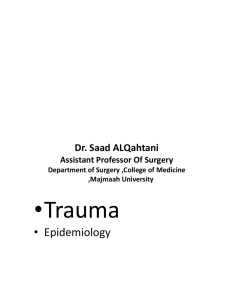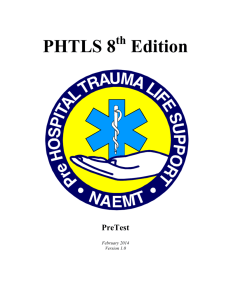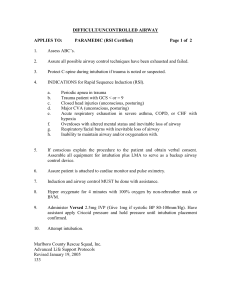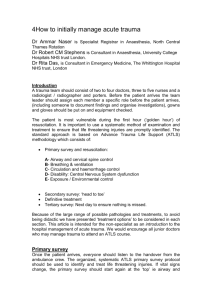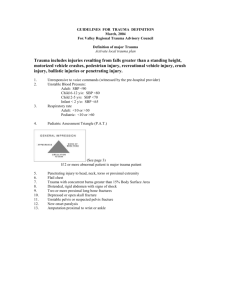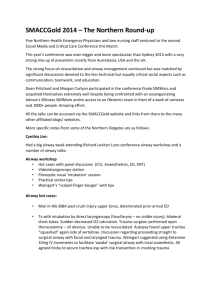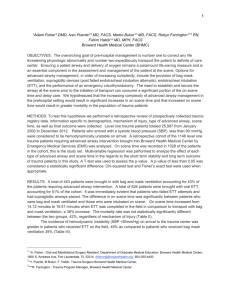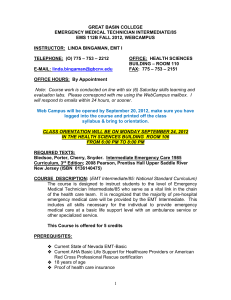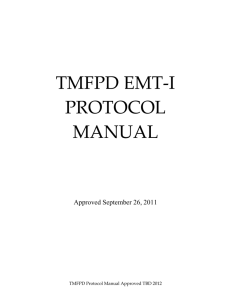Routine trauma care guideline
advertisement
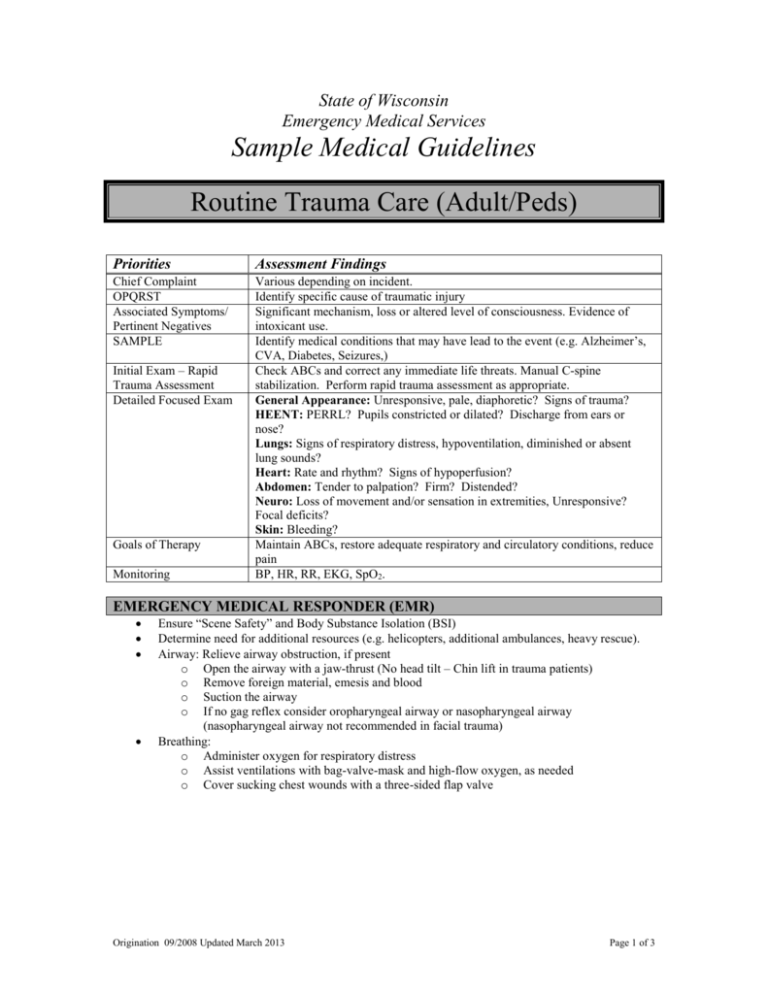
State of Wisconsin
Emergency Medical Services
Sample Medical Guidelines
Routine Trauma Care (Adult/Peds)
Priorities
Assessment Findings
Chief Complaint
OPQRST
Associated Symptoms/
Pertinent Negatives
SAMPLE
Various depending on incident.
Identify specific cause of traumatic injury
Significant mechanism, loss or altered level of consciousness. Evidence of
intoxicant use.
Identify medical conditions that may have lead to the event (e.g. Alzheimer’s,
CVA, Diabetes, Seizures,)
Check ABCs and correct any immediate life threats. Manual C-spine
stabilization. Perform rapid trauma assessment as appropriate.
General Appearance: Unresponsive, pale, diaphoretic? Signs of trauma?
HEENT: PERRL? Pupils constricted or dilated? Discharge from ears or
nose?
Lungs: Signs of respiratory distress, hypoventilation, diminished or absent
lung sounds?
Heart: Rate and rhythm? Signs of hypoperfusion?
Abdomen: Tender to palpation? Firm? Distended?
Neuro: Loss of movement and/or sensation in extremities, Unresponsive?
Focal deficits?
Skin: Bleeding?
Maintain ABCs, restore adequate respiratory and circulatory conditions, reduce
pain
BP, HR, RR, EKG, SpO2.
Initial Exam – Rapid
Trauma Assessment
Detailed Focused Exam
Goals of Therapy
Monitoring
EMERGENCY MEDICAL RESPONDER (EMR)
Ensure “Scene Safety” and Body Substance Isolation (BSI)
Determine need for additional resources (e.g. helicopters, additional ambulances, heavy rescue).
Airway: Relieve airway obstruction, if present
o Open the airway with a jaw-thrust (No head tilt – Chin lift in trauma patients)
o Remove foreign material, emesis and blood
o Suction the airway
o If no gag reflex consider oropharyngeal airway or nasopharyngeal airway
(nasopharyngeal airway not recommended in facial trauma)
Breathing:
o Administer oxygen for respiratory distress
o Assist ventilations with bag-valve-mask and high-flow oxygen, as needed
o Cover sucking chest wounds with a three-sided flap valve
Origination 09/2008 Updated March 2013
Page 1 of 3
Circulation:
o Control external hemorrhage with direct pressure.
Apply a tourniquet for severe hemorrhage from an extremity that is not
controlled with direct pressure or when direct pressure is not practical (limited
resources, tactical situation, complicated extrication)
o If the patient arrests,
Re-assess the airway and oxygen delivery
Consider initiating the Cardiac Arrest Guidelines.
Prolonged efforts to restore spontaneous circulation in a traumatic arrest should
not be made
CPR should not be attempted if:
Blunt trauma caused the arrest
There are other injured survivors with urgent needs for help
C-Spine: Manual stabilization
Splint obvious extremity fractures
Refer to Pain Management Guidelines
Begin other interventions as needed according to specific guidelines
EMERGENCY MEDICAL TECHNICIAN (EMT)
Consider hemostatic agents for bleeding not controlled by direct pressure and when tourniquet
application is not feasible
If there is ALOC
o Check Blood Glucose and follow Hypoglycemia Guidelines if <60
Spinal Immobilization, as indicated.
Refer to the Trauma Field Triage Guidelines to consider possible transport to a Regional Trauma
Center
ADVANCED EMT (AEMT)
Initiate IV/IO (18ga or larger) NS.
Consider 2nd IV/IO where hypovolemia is suspected (Adult only)
(Adult) If SBP < 100 mmHg or heart rate > 120, initiate a fluid bolus of Normal Saline: 500 ml
(Peds) {if approved for peds IV}
o Infant – 6 months : If SBP < 60 mmHg initiate 20cc/Kg bolus
o 6 months – 5 years : If SBP < 70 mmHg initiate 20cc/Kg bolus
o 6 years – 12 years : If SBP < 80 mmHg initiate 20cc/Kg bolus
Contact Medical Control for the following:
Additional fluid orders
INTERMEDIATE
Respiratory arrest or apnea
o Consider endotracheal intubation
If tension pneumothorax is suspected perform needle decompression.
Consider IO or external jugular (EJ) IV if IV cannot be established in the extremities.
Contact Medical Control for the following:
Pain control
PARAMEDIC
If the airway is obstructed or obstruction is imminent and 2 attempts to intubate the trachea have
failed, insert a non-visualized airway.
If airway management otherwise fails, perform surgical or needle cricothyroidotomy.
Origination 09/2008 Updated March 2013
Page 2 of 3
Consider gastric decompression with nasogastric tube, unless contraindicated by facial trauma or
skull fracture
Contact Medical Control for the following:
Additional orders
Origination 09/2008 Updated March 2013
Page 3 of 3



